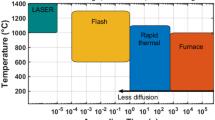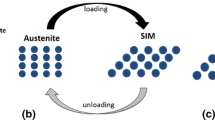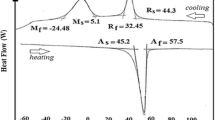Abstract
This paper experimentally studies the improvement in the actuator response of TiNi shape memory wires brought about by thermal treatments. Heat-treated TiNi wires were thermally cycled at zero stress before being trained by constant stress to develop the two-way shape memory effect. Subsequently, the work output of these two-way memory TiNi shape memory alloys are measured during repeated thermomechanical cycling under various levels of constant stress. Changes in the phase transformation behavior in two-way memory and thermomechanically cycled TiNi shape memory alloy wires are quantified by x-ray diffraction as a function of temperature. The weight fraction diagrams of TiNi wires thermally cycled at zero stress before they were trained suggests that during constant stress training they develop a lower quantity of R-phase than samples that have not been thermally cycled at zero stress before being trained. This gives thermally cycled TiNi samples higher levels of transformation strain and work output during thermomechanical cycling than samples that have not been thermally cycled before training. These results suggest that for the best material performance—that is, significant transformation strain and, consequently, substantial work output—the TiNi wire should be thermally cycled at zero stress before training.













Similar content being viewed by others
References
J. Matovic and K. Reichenberger, Two-Way SMA Actuators for Space Application, Performances and Reliability, Procedia Eng., 2010, 5, p 1372–1375
L. Petrini, F. Migliavacca, Biomedical Applications of Shape Memory Alloys, J. Metall., 2011, p 501483
J.V. Humbeeck, Shape Memory Alloys: A Material and a Technology, Adv. Eng. Mater., 2001, 3(11), p 837–850
T. Simon, A. Kroger, C. Somsen, A. Dlouhy, and G. Eggeler, On the Multiplication of Dislocations During Martensitic Transformations in NiTi Shape Memory Alloys, Acta Mater., 2010, 58, p 1850–1860
J. Bhaggyaraj, G. Gouthama, K.V. Ramaia, C.N. Saijkrisnna, and S.K. Bhauumik, TEM Studies on the Microstructural Changes During Thermomechanical Cycling of NiTi Shape Memory Alloy Wire, Mater. Sci. Forum, 2012, 702–703, p 904–907
D.A. Miller and D.C. Lagoudas, Influence of Cold Work and Heat Treatment on the Shape Memory Effect and Plastic Strain Development of NiTi, Mater. Sci. Eng. A, 2001, 308, p 161–175
X.M. Zhang, J. Fernandez, and J.M. Guilemany, Role of External Applied Stress on the Two-Way Shape Memory Effect, Mater. Sci. Eng. A, 2006, 438–440, p 431–435
Y. Liu, The Work Production of Shape Memory Alloys, Smart Mater. Struc., 2004, 13, p 552–561
C. Urbina, S. De la Flor, and F. Ferrando, Effect of Thermal Cycling on the Thermomechanical Behaviour of NiTi Shape Memory Alloys, Mater. Sci. Eng. A, 2009, 501, p 197–206
C. Urbina, S. De la Flor, F. Gispert, and F. Ferrando, Two Way Shape Memory Efficiency of the Ti-Ni 54.4 wt (%) Enhanced by Thermal Treatments, Funct. Mater. Lett., 5005, 6(6), p 1350057–1350061
S. Miyazaki, Y. Igo, and K. Otsuka, Effect of Thermal Cycling on the Transformation Temperatures of TiNi Alloy, Acta Metall., 1986, 34, p 2045–2051
H.C. Ling and S.K. Wu, The Tensile Behaviour of a Cold-Rolled and Reverse-Transformed Equiatomic TiNi Alloy, Acta Metall. Mater., 1994, 42, p 1623–1630
C. Urbina, S. De la Flor, F. Gispert, and F. Ferrando, Quantitative XRD Analysis of the Evolution of the TiNi Phase Transformation Behavior in Relation to Thermal Treatment, Intermetallics, 2010, 18(8), p 1632–1641
G. Stinton and J. Evans, Parametric Rietveld Refinement, J. Appl. Crystall., 2007, 40, p 87–95
TOPAS V3.1 General Profile and Structure Analysis Software for Powder Diffraction Data, Bruker AXS Karlsruhe, Germany, 2005
A.E. Dwight, CsCI-Type Equiatomic Phases in Binary Alloys of Transition Element, Trans. AIME, 1959, 215, p 283–286
Y. Kudoh, M. Tokonami, S. Miyazaki, and K. Otsuka, Crystal Structure of the Martensite in Ti—49.2 at.% Ni Alloy Analyzed by the Single Crystal X-Ray Diffraction Method, Acta Metall., 1985, 33, p 2049–2056
C. Urbina, S. De la Flor, F. Gispert-Guirado, and F. Ferrando, New Understanding of the Influence of the Pre-Training Phase Transformation Behaviour on the TWSME in NiTi SMA Wires, Exp. Mech., 2013, 53(8), p 1415–1436
Y. Liu and P.G. McCormick, Two Way Shape Memory Effect in NiTi, Mater. Sci. Forum, 1990, 56, p 585–590
H. Prahlad, I. Chopra, Experimental Characterization of Ni-Ti Shape Memory Alloy Wires Under Complex Loading Conditions, Proc. SPIE, 1999, p 3668–3604
E. Abel, H. Luo, M. Pridham, and A. Slade, Issues Concerning the Measurement of Transformation Temperatures of NiTi Alloys, Smart Mater. Struc., 2001, 13, p 1110–1117
H. Matsumoto, Electrical Resistivity of NiTi with a High Transformation Temperature, J. Mater. Sci. Lett., 1992, 11, p 367–368
S. Turenne, S. Prokoshkin, V. Braislovski, and N. Sacépé, Mechanical and X-Ray Characterization of the Assisted Two-Way Shape Memory Effect in NiTi, Can. Metall. Quart., 2000, 39, p 217–224
Z.G. Wang, X. Zu, T.P. Fu, Y. Dai, S. Zhu, and L.M. Whang, Two-Way Shape Memory Effect of TiNi Alloy Coil Extension Springs, Mater. Sci. Eng. A, 2003, 360, p 126–131
S. Belyaev, N. Resnina, and A. Sibirev, Peculiarities of Residual Strain Accumulation During Thermal Cycling of TiNi Alloy, J. Alloys Compd., 2012, 542(25), p 37–42
K. Wada and Y. Liu, Shape Recovery of NiTi Shape Memory Alloy Under Various Pre-Strain and Constraint Conditions, Smart Mater. Struct., 2005, 14, p 5273–5286
K. Wada and Y. Liu, Thermomechanical Training and the Shape Recovery Characteristics of NiTi Alloys, Mater. Sci. Eng. A, 2008, 481–482, p 166–169
V. Braislovski, P. Terriault, and S. Prokoshkin, Influence of the Post-Deformation Annealing Heat Treatment on the Low-Cycle Fatigue of NiTi Shape Memory Alloys, J. Mater. Eng. Perf., 2002, 11, p 614–621
G. Scirè and E. Dragoni, Functional Fatigue of Shape Memory Wires Under Constant-Stress and Constant-Strain Loading Conditions, Eng. Procedia, 2011, 10, p 3692–3707
Author information
Authors and Affiliations
Corresponding author
Rights and permissions
About this article
Cite this article
Urbina, C., De la Flor, S., Gispert-Guirado, F. et al. Actuator Response of Improved Two-Way Memory TiNi Wires Evaluated by Weight Fraction Diagrams. J. of Materi Eng and Perform 23, 1680–1694 (2014). https://doi.org/10.1007/s11665-014-0933-8
Received:
Revised:
Published:
Issue Date:
DOI: https://doi.org/10.1007/s11665-014-0933-8




